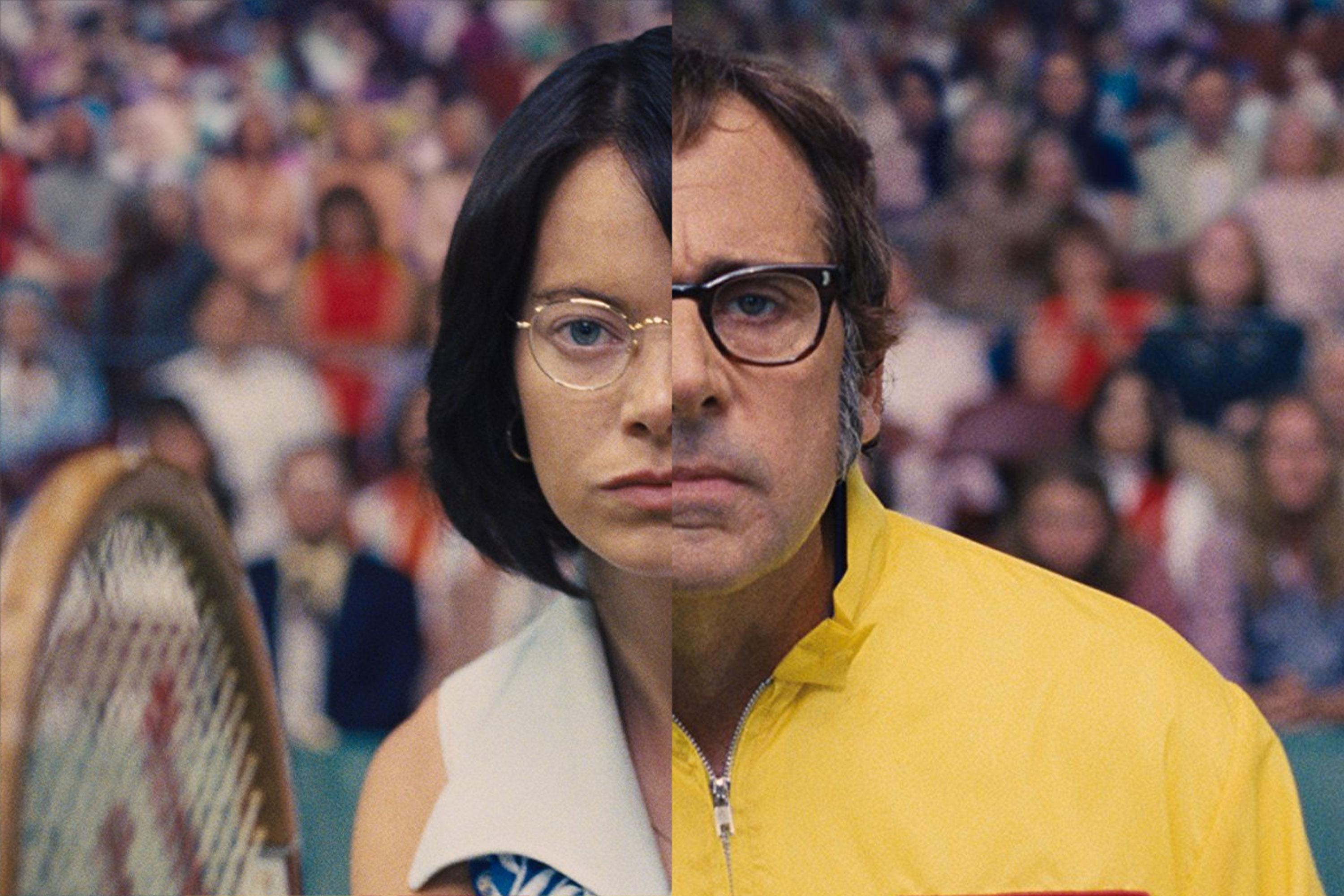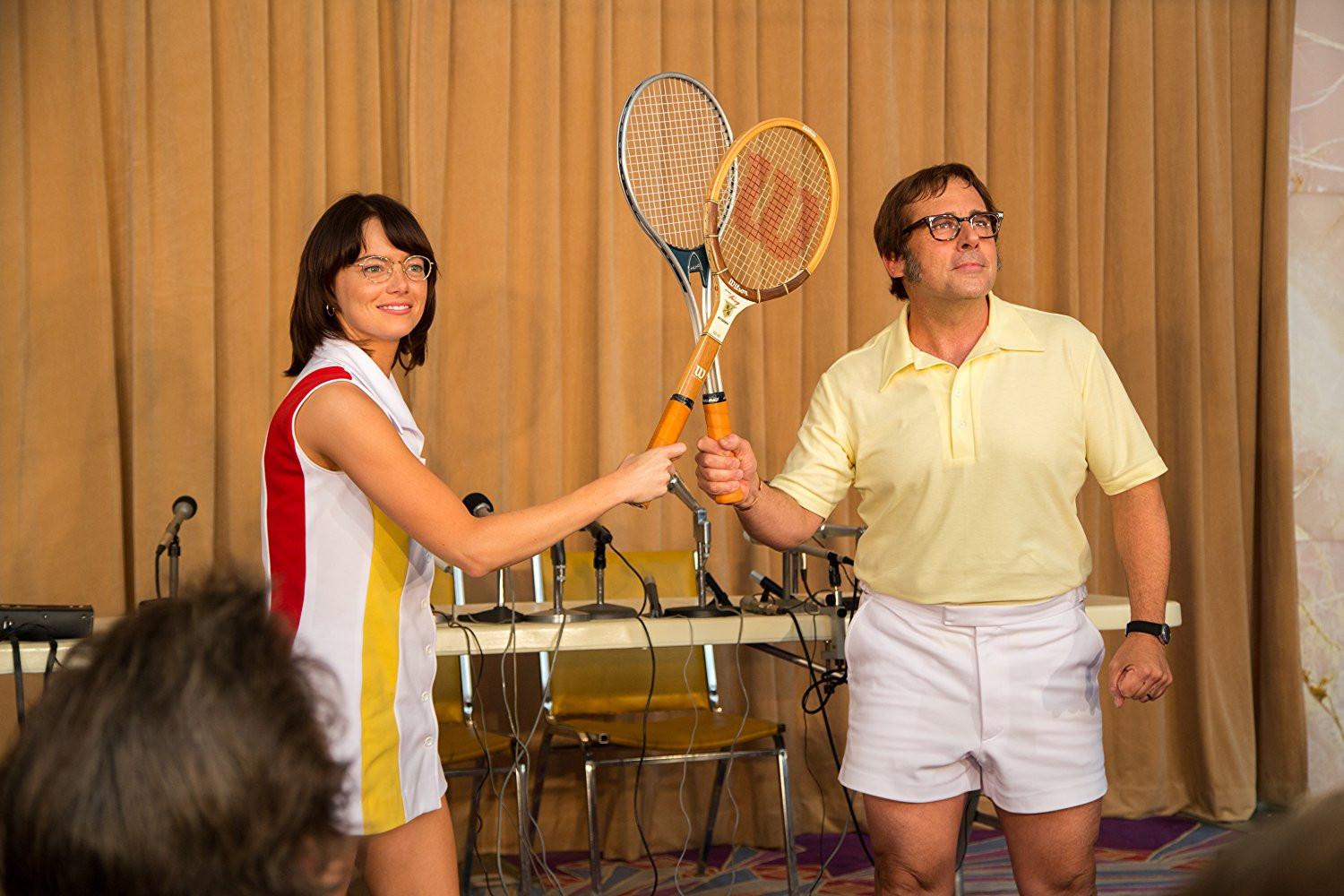
No sport reflects the spirit of one-on-one competition like tennis, and there are two movies battling for supremacy inside Battle of the Sexes, Jonathan Dayton and Valerie Faris’s slick, pleasing dramatization of the much-publicized 1973 exhibition match between Bobby Riggs and Billie Jean King. The first movie is a witty, purposeful period-piece parable whose time has very much come: watching Riggs’s self-described “chauvinist pig” get run off the court by self-styled feminist (and pay-equity activist) King is undeniably satisfying in a zeitgeist that still bristles with a glib, institutionalized misogyny. But for all its embedded tension and power — and expertly engineered moments of pure, crowd-pleasing elation — Battle of the Sexes is also an example of the kind of cautious, calculated film and filmmaking that does progressive subject matter no favors. Not content with simply stimulating audience reaction, it also seeks to control them down to the last inch.
Admittedly, Dayton and Faris are dealing with loaded material that doesn’t necessarily invite subtle artistic treatment, beginning with Riggs, who is inhabited by Steve Carell with just the right combination of playfulness and sullen self-delusion. In Foxcatcher, the actor turned his impersonation of a real-life figure, the demented “ornithologist, philatelist, philanthropist,” and murderer John Du Pont, into a Peter Sellers–like exercise in stylized grotesquerie, but he’s more relaxed as Riggs, whose willingness to play the fool was completely self-conscious, but whose bitter, sexist agenda still comes through. If we’re meant to see a bit of Donald Trump in Riggs’s bloated, media-savvy horseplay, it’s just enough to elicit a shiver of recognition without transforming things into an obvious present-tense allegory; while nobody will mistake Carell’s work for understatement, his sense of villainy is proportionate to the story being told.
The problem — and it’s a complicated one — is Emma Stone as Billie Jean King, which is not to say that Stone has given a bad performance, or even that there’s much more that she could have done to make things better. Stone’s weakness as an actress is her tendency to turn up the adorability — all the way to 11 in La La Land, which is why she got an Oscar — and to her credit, she cuts down on the doe-eyed charm here, leaning into King’s agile body language and flinty cadences with a lot of skill. Stone is believable as a poised, polished athlete, a rabble-rouser (the film begins with her pulling out of the existing women’s tennis tour and starting up her own venture behind the sponsorship of Virginia Slims), and a woman who’s learned to channel some deeper discomfort about inner life into a monastic, disciplined routine. And yet the character doesn’t quite contain multitudes. Simon Beaufoy’s screenplay is so dedicated to canonizing King from every angle — not just as an athlete and a gender warrior, but also as a woman painfully coming to terms with her repressed homosexuality — that Stone’s acting feels stuck in a dully noble register.

Battle of the Sexes means to be frank and daring, but everything is sanitized and safe. Scenes that should be charged with emotion, like King’s first romantic encounter with her hairdresser turned love, Marilyn Barnett (Andrea Riseborough), and subsequent, unspoken confessional with her husband, Larry (Austin Stowell), suffer from a treatment that’s determined to keep us from ever judging the heroine too harshly. Stone’s modulation of King’s mounting anxiety, insecurity, and wavering focus before the Riggs match gets undermined by Dayton and Faris’s insistence on her infallibility, which renders the uplift of the finale a foregone conclusion in dramatic terms as well as historical ones.
It also doesn’t help that Beaufoy trots out a series of devices that come perilously close to insulting the audience’s intelligence, like depicting Bill Pullman’s women’s tennis circuit honcho Jack Kramer as one small white cat short of being a Bond villain (he spends most of his screentime drinking in dark, luxurious boys’ club rec rooms), or using Alan Cumming’s fey fashion designer Ted as a mouthpiece for the frustrations of a life lived in the closet. When the match finally happens, the filmmakers cut between sweaty men frowning in front of their televisions and women in the crowd watching with feverish intensity. When the divisions between the good guys and the bad guys are so clearly drawn in the storytelling equivalent of white chalk, it can make the viewing experience feel like a rigged game.
As far as being a sports movie, Battle of the Sexes works well enough, borrowing the Rocky template of crisscrossing training montages (with Riggs very much an arrogant, camera-hungry Apollo Creed figure) and re-creating the event itself with documentary veracity. The tennis is believably staged and choreographed — and shot at enough of a distance that Carell’s and Stone’s famous faces don’t distract from the authenticity. Considering Faris and Dayton’s background in sketch comedy (evoked in a welcome cameo by their fellow Mr. Show alum Tom Kenny), the physical size and scope of the production is impressive. Battle of the Sexes has been shot, luminously, on 35-millimeter film by Linus Sandgren, giving it an appropriately ’70s feel, but with less of the overt fetishism that tends to characterize awards-season period pieces. (One clever touch: Riggs watching a clip of The Mary Tyler Moore Show — a pop-cultural equivalent to his opponent’s proud, public-eye feminism.)
The level of craft and intelligence that goes into making a movie that affects an audience like this one does is not inconsiderable. Worse things can be said about a film than that it’s effective. But effective films can also be annoying. “Times change,” a character tells Billie Jean at one point. “You should know, because you changed them.” There’s a kind of movie in which that line would be a powerful and poetic grace note, and a kind of movie in which it rings hollow. Unfortunately, Battle of the Sexes has it both ways.